Introduction of Kitchen Sink
The kitchen sink is the unsung hero of virtually every home. You use it dozens of times a day—for washing dishes, prepping meals, watering plants, or even filling a bucket. Understanding your kitchen sink options and knowing how to choose the right style, material, and installation method can significantly elevate bth the function and the aesthetic of your kitchn. In this comprehensive guide, you’ll learn all about kitchen sink styles, materials, maintenance tips, installation advice, and common mistakes to avoid.
Why the kitchen sink deserves more attntion than you might have given it. It’s not just a place to wash up—it’s the hub of kitchen activity. Whether you’re a busy parent rinsing vegetables, a baker washing bowls, or a homeowner prepping dinner for guests, the kitchen sink plays a vital role. Choosing the right sink can simplify your daily routine, reduce clutter, and enhance hygiene.
In this edition, you will:
- Discover all popular types of kitchen sinks and their pros and cons
- Compare materials from stainless steel to fireclay, granite composite, and copper
- Learn how to size a sink correctly and plan your countertop layout
- Explore installation methods: drop-in, undermount, apron-front (farmhouse), and integrated
- Understand everyday care, stain prevntion, and dealing with hard water
- Follow step‑by‑step advice for avoiding installation mistakes
- See real-world examples of stylish, functional sink setups
- Get answers to frequently asked kitchen sink questions
You’ll feel confident choosing, installing, and maintaining a kitchen sink that suits your lifestyle, fits your pantry, and enhances your kitchen design for years to cme.
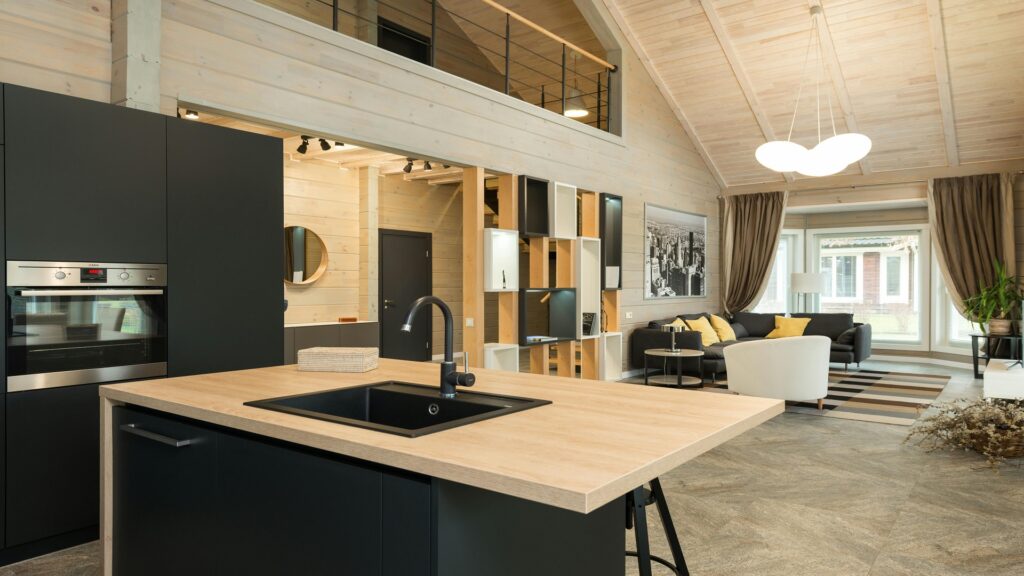
What is a Kitchen Sink?
A kitchen sink is more than a basin—it’s a multi-purpose tool that forms the center of kitchen activities. Typically installed flush into a counter or set into a base cabinet, the sink is connected to bth hot and cold water supply lines, alng with a drain that connects to your home’s plumbing system.
Types of Kitchen Sinks
- Drop-In / Top-Mount: Esy to install, this styl drops into a hole cut in the countertop and secures with clips. The rim remains visible on the countr surface—great for DIYers.
- Undermount: Mounted from beneath, this creates a seamless countertop edge and makes cleaning crumbs off the counter easier. Preferrd for stone and solid surfce counters.
- Apron-Front / Farmhouse: Featurs an exposed front, often deeper and wider than standard sinks—ideal for soaking large pots and pans. Offrs a statement piece in traditional and modern kitchens.
- Integrated / Built-In: Made from the same material as your countertop, creating a completely seamless look. Popular in modern, minimalist kitchens.
- Bar / Prep Sink: Smaller secondary sinks are placed in a pantry, island, or wet bar. Hndy for washing produce or keeping the main sink free during parties.
- Utility / Laundry Sink: Deeper and more rugged, idel for cleaning big items, pet care, or handyman tasks, nt usully found in the main kitchen.
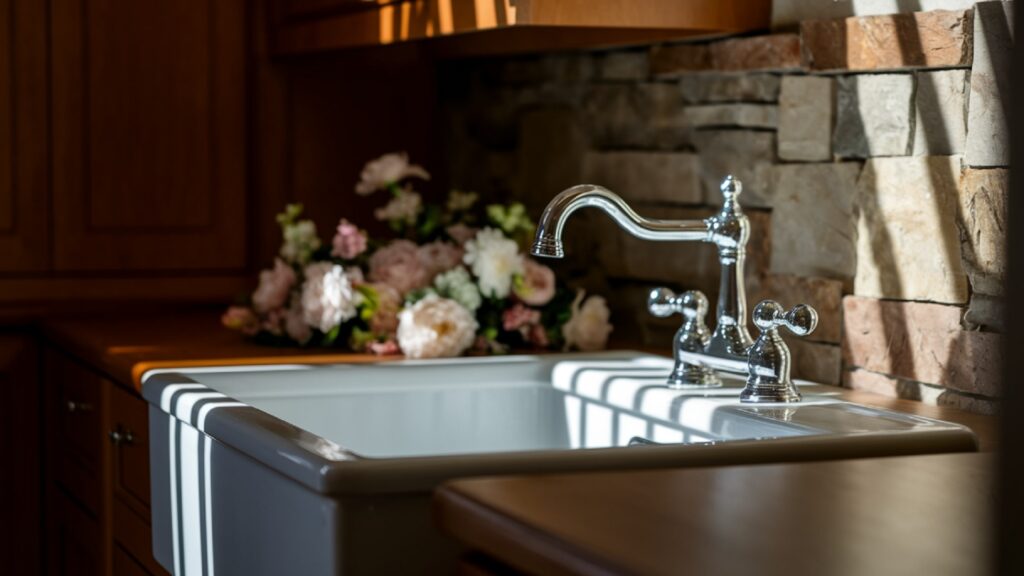
A typical kitchen sink also includes length and width dimensons suited to your countertop cut-out. Depth choices range from about 7 to 12 inches; a deeper basin reduces splashes but may require you to reach farther down.
Materials Overview
- Stainless Steel: Durable and affordable, this material is available in 16- or 18-gauge thicknesses. Scratches are less visible, and it resists heat and staining, although it can be noisier when washing.
- Granite Composite: Blended from stone and resin, this material is heavy, scratch-resistant, and vibrant in color. It resists staining and maintains its look over time.
- Fireclay / Porcelain: Offrs a glossy, classic appearance and a wide color range. It is very durable and resistant to stains; however, it is also heavy and prone to chipping. If struck forcefully.
- Cast Iron with Enamel: Highli durble wth a glossy, integrated surface. It retains heat well but is quite heavy and may chip if struck.
- Copper / Bronze: Antimicrobil qualities, unique aging patinas, and a luxurious look. Requires periodic polishing and careful cleaning.
- Quartz Composite: Similar to granite, made from crushed quartz and resin. It offers high strength, heat resistance, and attractive colors.
Benefits of Kitchen Sink
When most people think of a kitchen sink, they think of a basin to wash dishes. But in trth, the kitchen sink is a vital hub of both function and form within your kitchen. From health and hygiene to design and convenience, the benefits of choosing the right kitchen sink go far beyond just washing up.
Let’s explore the real-world advantages that a well-chosen kitchen sink brings to your home:
1. Hygiene and Cleanliness
First and foremost, the kitchen sink is where we tackle most food prep and cleanup. From rinsing vegetables to washing raw meat residue off cutting boards, hygiene begins at the sink.
Modern sinks now come with antibacterial coatings or are made of materials like stainless steel or copper that naturally resist bactria. Choosing the right sink can reduce your exposure to harmful germs and improve food safety in the kitchen.
Deeper sinks help reduce splashing and spillage, which keeps your countertops cleaner and safer.
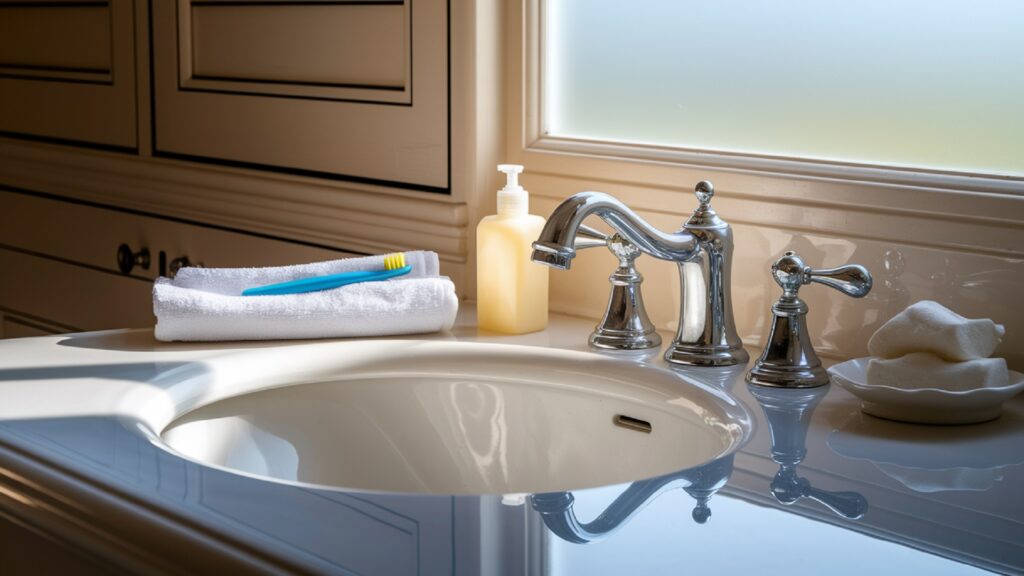
2. Enhanced Functionality
In addition to basic cleaning tasks, your kitchen sink can serve multiple other purposes:
- Prepping food: Washing greens, draining pasta, or thawing meat
- Filling pots and pitchers: Some deep basins make it easier to fill large pots or watering cans
- Soaking large cookware: A single-bowl or farmhouse sink makes soaking roasting pans or trays effortless
- Multi-tasking: With the right accessoris—like colanders, cutting boards, and drying racks—your sink becomes a prep station
With accessories and thoughtful design, your sink can support your cooking and cleaning routines rather than hinder them.
3. Style & Design Integration
In modern kitchen design, the sink has become a focal point instead of merely serving as a utility item.
A sleek undermount stainless steel model fits seamlessly into a contemporary kitchen. Meanwhile, a bold apron-front fireclay sink adds rustic charm to farmhouse or cottage-style kitchens.
Manufacturers now provide sinks in various finishes and colors—matte black, brushed nickel, or even bright copper—to match your kitchen’s overall aesthetic.
In addition, coordinating your sink with the faucet, backsplash, and cabinetry helps tie together the entire design.
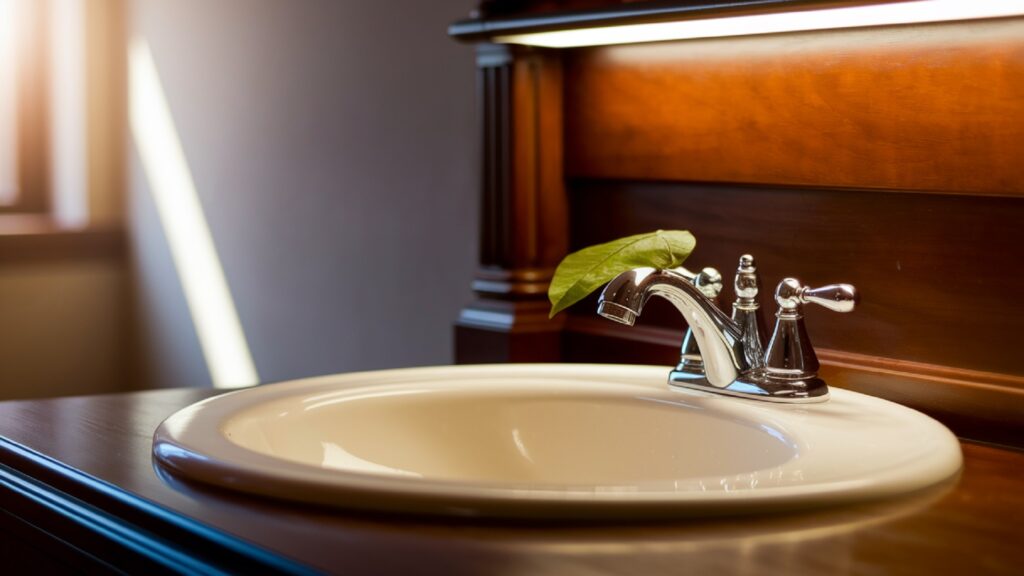
4. Eco-Friendly Features
Today’s kitchen sink options also support greener living:
- Low-flow faucets help reduce water waste without sacrificing performance
- Dual-basin sinks allow you to use one side for rinsing and one side for soaking, which saves water
- Smart sensors and touchless features promote water consrvation and hygiene
If you’re conscious about your water usage, look for WaterSnse-certified faucets to pair with your sink.
5. Durability and Investment Value
Kitchen sinks endure a lot—hot pans, sharp knives, abrasive sponges, and more. The right material will hold up to years of daily use.
- Stainless steel sinks can last decades with minimal maintenance
- Granite and quartz composite sinks resist stains, scratches, and fading
- Fireclay and enamel sinks maintain their elegant shine for years when cared for properly
In addition, a good quality kitchen sink can enhnce the resale value of your home. Homebuyers often consider the kitchen the most importnt room, and a premium sink adds both function and luxury.
6. Customization and Layout Efficiency
With many layout options—single or double basin, workstation sinks, and integrated cutting boards—your kitchen sink can be tailored to your specifc needs.
- Do you batch cook? You’ll love a deep single-bowl sink.
- Do you do dishes by hand? A dual-basin option might be more efficient.
- Live in a small space? A corner or prep sink can help maximize countertop space.
Workstation sinks, in particular, have become popular in 2025. These include a tiered design with built-in accessories like drain trays, cutting boards, and drying racks that fit snugly inside the sink. This keeps your counter clutter-free and your workflow streamlined.
7. Convenience for Every Type of Home
No matter the size or style of your kitchen, there is a kitchen sink solution to match:
- Small apartments benefit from compact single-bowl designs with drying racks
- Family homes often need large farmhouse or double-basin models
- Luxury kitchens lean toward quartz or fireclay sinks integrated with smart features
Furthermore, thoughtful sink placement—like installing it near the stove or dishwasher—can save steps and make your kitchen more ergonomic.
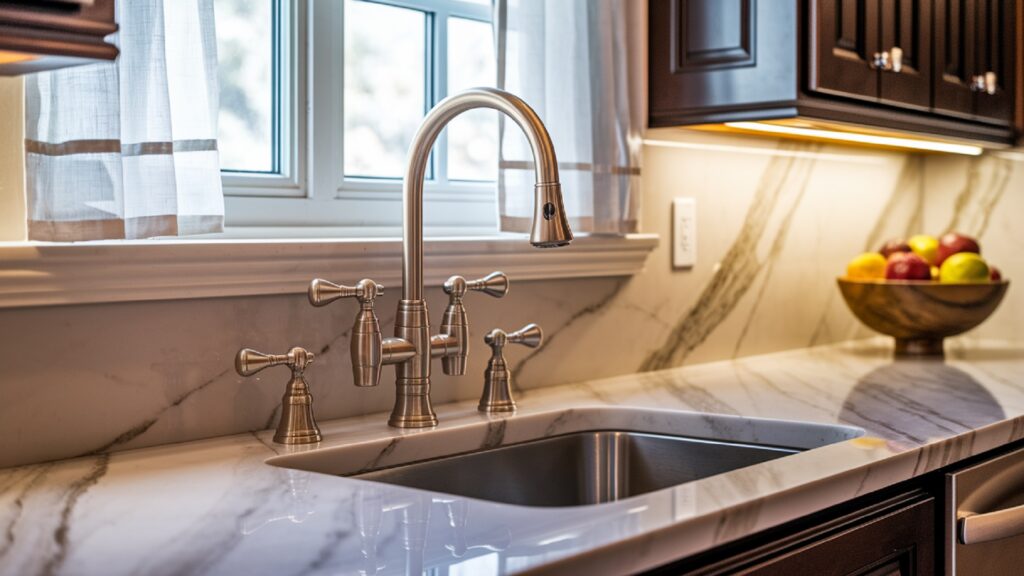
8. Easy Upgrades Without Full Remodel
One of the most overlooked advantages? Upgradng your kitchen sink is one of the easiest ways to modernize your kitchen without needing a full remodel.
A new sink and faucet can completely change the tone of your kitchen. From industrial and modern to vintage and cozy, your sink style helps define the space.
And because many new models are designed to fit standard cutouts, you may be able to swap your sink without major countertop changes.
How to Use a Kitchen Sink Effectively
A kitchen sink is simple in concept, but using it efficiently requires the right setup, accessories, maintenance practices, and even daily habits. Whether you’r cooking for a large family or living in a small aprtment, knowing how to use your kitchen sink effectively can save you time, reduce stress, and keep your kitchen hygienic and organized.
Let’s break this down into practical, actionable steps:
🧰 1. Choose the Right Faucet and Fixtures
The faucet plays just as important a role as the sink bowl itself. It determines water flow, reach, and temperature control, and can evn offer smart features. Here’s what to look for:
- Pull-Down or Pull-Out Sprayers – These make it easier to rinse dishes and clean around the basin.
- Touchless Faucets – Grat for hygiene, these reduce water waste and keep the handle clean.
- Adjustable Water Pressure – Allows you to conserve water when neded or blast off food when necessary.
- Swivel Spouts – Perfect for double-bowl sinks so you can move the faucet from one side to the other.
💡 Pro tip: Install an aerator on your faucet to reduce splashing and conserve water.
🪟 2. Maximize Workflow with Smart Sink Placement
Your kitchen sink should be placed in a way that aligs with the “kitchen work triangle”—between the stove, fridge, and prep area. This layout minimizes steps between food prep, cooking, and cleanup. If possible:
- Position the sink under a window for natural light
- Place the dishwashr beside the sink for easy loading
- Keep trash bins within reach for efficient food scrap disposal
A well-planned kitchen flow can make even a small kitchen feel bigger and more functional.
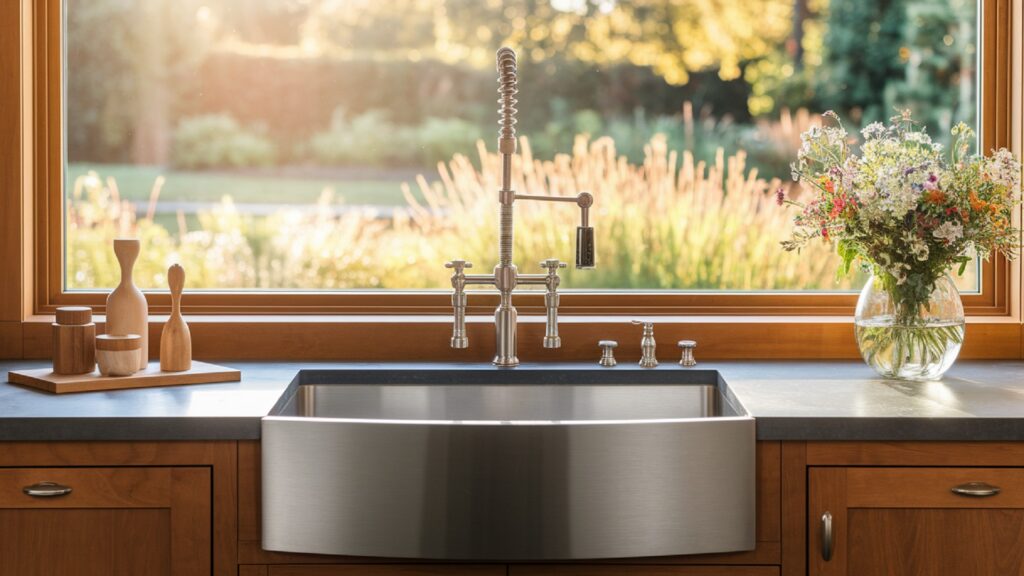
🧺 3. Use Sink Accessories to Expand Functionality
Modern sinks come wth built-in or add-on features that help you do more in less space. Consider using:
- Over-the-sink cutting boards – Prep food directly over the basin
- Roll-up drying racks – Air dry dishes without taking up counter space
- Drain baskets or colanders – Rinse produce and strain pasta with ease
- Sink caddies or suction organizers – Keep spongs and scrubbers tidy
- Grid mats – Protect the base of the sink from scratches and dents
These accessories transform your sink into a multi-purpose workstation.
🧼 4. Clean and Maintain the Sink Regularly
To keep your kitchen sink functioning well and looking new, establish a cleaning routine:
Daily:
- Rinse the sink after each use
- Wipe down the basin with dish soap and warm water
- Remove food debris from the drain basket
Weekly:
- Scrub the basin and faucet with a soft sponge
- Use a baking soda paste or a gentle cleaner on stainless steel
- Pour a mix of vinegar and baking soda down the drain to break up the buildup
Monthly:
- Check for leaks under the sink
- Clean faucet aerators and sprayr heads
- Deep clean granite or fireclay surfaces with a non-abrasive solution
🛑 Avoid using steel wool or harsh chemicals on fireclay, enamel, or composite sinks, as it can scratch or dull the finish.
📏 5. Know the Right Way to Load and Use Your Sink
Using your sink efficiently can also help reduce effort and extend its lifespan. Here’s how:
- Don’t overload dishes; it restricts water flow and increases breakage risk
- Scrape off food into a compost bin before rinsing
- Soak pans and baked-on dishes to make scrubbing easier
- Wash in batches: glasses first, then plates, cookwre
- Use a separate bowl or tub in one basin if you don’t have a double sink
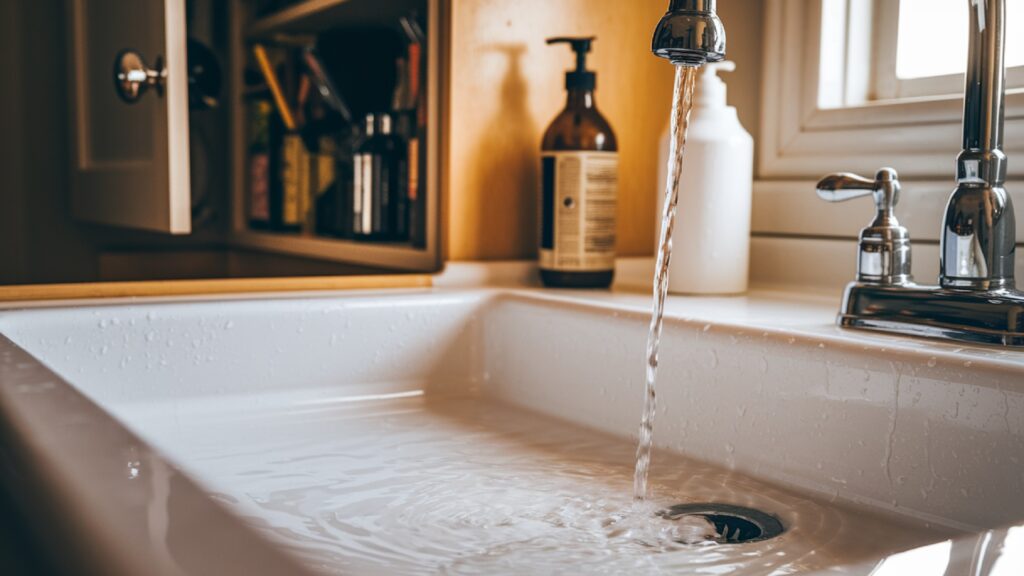
⚠️ Common Myths to Avoid
There are a few myths and outdated habits surrunding kitchen sink use that can cause damage:
- Myth: Bleach keeps your sink clean – It can corrode plumbing and damage enamel finishes.
- Myth: You can pour any liquid down the sink. Grease and oils harden in pipes and cause clogs.
- Myth: Garbage disposals can handle anything – Bones, coffee grounds, and pasta can all damage the unit.
Always follow the manufactrer’s care instructions, especially for unique materials like copper or quartz composite.
🛡️ Pro Maintenance Tips
- Use a sink mat or grid to prevent scratches
- Install a water softener if you live in a hard water area to avoid minerl deposits
- Apply a sealant to granite or stone sinks every 1–2 years
- Don’t leave metal utensils sitting in the sink overnight—they can rust and stain the surface
🧼 Suggested Cleaning Supplies
| Product | Use | Best For |
|---|---|---|
| Baking Soda | Gentle scrubbing | Stainless steel, enamel |
| White Vinegar | Descaling | Faucets, drains |
| Soft sponge | Everyday cleaning | All sink types |
| Microfiber cloth | Polishing | Chrome, copper finishes |
Effective use of your kitchen sink isn’t just about rinsing and draining—it’s about ergonomics, hygiene, time managment, and evn design flow. The more you customize and maintain your sink, the more it will support your cooking, clening, and everyday life.
Common Mistakes People Make
Even though the kitchen sink seems like a straightforwrd feature, homeowners and renovators often make critical mistakes when choosing, installing, or maintaining it. These errors can result in functionality issues, costly repairs, or an underwhelming kitchen experience.
Let’s walk through the most common pitfalls to avoid so your sink works flawlessly for years.
❌ 1. Choosing the Wrong Sink Size
One of the most frequent mistakes is selecting a sink that doesn’t suit your space or needs. Bigger isn’t always better—especially in compact kitchens.
What goes wrong?
- A large farmhouse sink in a small kitchen can dominate the space and eat up valuable countertop room.
- A shallow or narrow sink may not accommodate large pots or baking trays.
Avoid it by:
- Measure your cabinet base before purchasing the sink.
- Considering how much cooking and dishwashing you do daily.
- Taking into acount your countertop material, some support heavy sinks better than others.
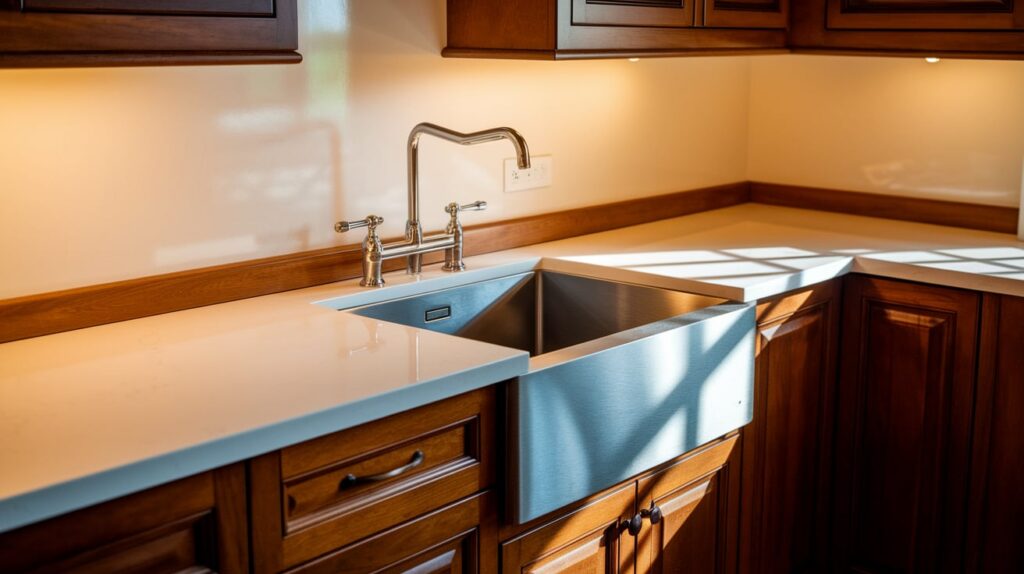
⚙️ 2. Ignoring Plumbing Requirements
Another common error is buying a new kitchen sink without undrstanding what changes (if any) it will require in plumbing.
What goes wrong?
- Installing a deep sink without adjusting the height of the P-trap can result in slow drainage.
- Failing to check if your garbage disposal fits under the new sink.
- Plumbing lines may need to be rerouted if you’re changng the sink location or style.
Avoid it by:
- Consult a plumber before buying a new sink.
- Matching the new sink depth with the existing plumbing to avoid unnecessary work.
- Make sur there’s enough space for bth plumbing and accessories beneath the cabinet.
🔧 3. Poor Installation Techniques
Improper installation can lead to leaks, water damage, and misalignment.
What goes wrong?
- Not sealing the sink edges properly can cause water seepage under the counter.
- Misaligned drains can result in clog-prone plumbing.
- Not using brackets or clips on drop-in sinks can make them unstable.
Avoid it by:
- Hiring a professional if you’re unsure about installation.
- Following the manufcturer’s installation instructions to the letter.
- Checking alignment before tightening fixtures and faucet mounts.
💦 4. Skipping Regular Cleaning
A clean sink is a healthy sink. But many people skip regular maintenance until stains or smells set in.
What goes wrong?
- Hard water builds up and creates limescale around the drain or faucet.
- Food debris left overnight creates odor and attracts bacteria.
- Over time, neglect can dull the finish or lead to corrosion.
Avoid it by:
- Rinse and dry your sink after every use.
- Cleaning it with baking soda or vinegar weekly.
- Deep-cleanng monthly based on your sink material (e.g., special cleaners for enamel or fireclay).
🛠️ 5. Using the Wrong Cleaning Products
Different sink materials require different care routines. Using the wrong cleaner can permanently damage your sink.
What goes wrong?
- Abrasive pads scratch stainless steel or composite sinks.
- Harsh chemicals like bleach can damage finishes and rubber seals.
- Acidic cleaners may etch or dull stone-based sinks.
Avoid it by:
- Read the manufcturer’s recommndations for maintenance.
- Use soft sponges or microfiber cloths.
- Testing new cleaning products in a small corner first.
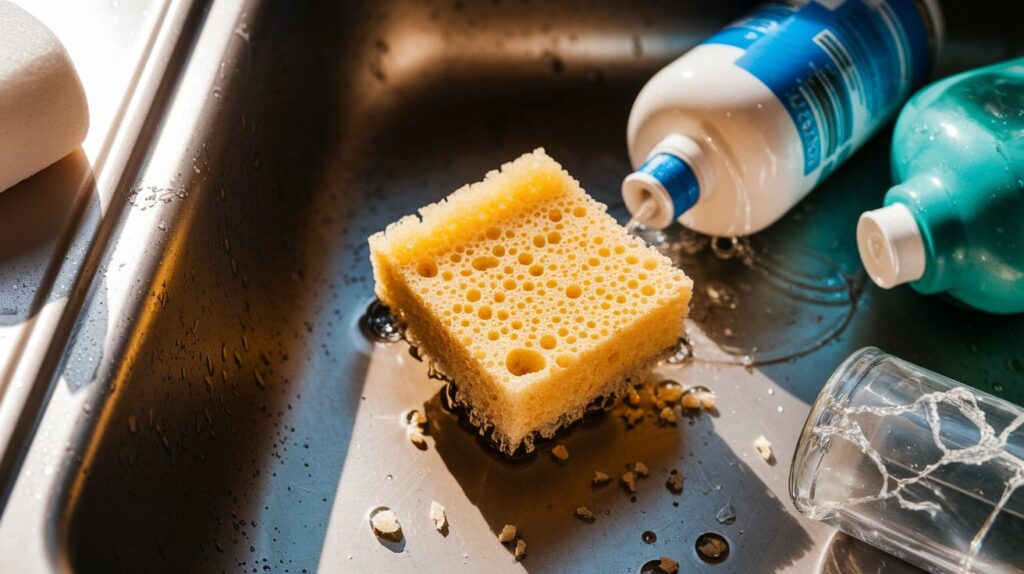
📦 6. Poor Accessory Fitment
Sinks that are not accessorized properly can become cluttered or inefficient.
What goes wrong?
- Purchasing an over-the-sink cutting board that doesn’t fit snugly.
- Buying drying racks that obstruct water flow or slip off the edges.
- Installing low-quality soap dispensrs that break or leak into the cabinet below.
Avoid it by:
- Buying accessories from the same brand or using universal measurements.
- Ensuring anti-slip grips are included with racks or colanders.
- Upgrading to better-quality hardware to match sink durability.
🔌 7. Forgetting About Under-Sink Storage
Under-sink cabinets are often overlooked. But failing to plan for the space can lead to clutter, mold, or plumbing interference.
What goes wrong?
- Bottles and cleaners block pipes or push against garbage disposal units.
- No shelving means wasted vertical space.
- Unsealed cabinets may get moldy from condensation or drips.
Avoid it by:
- Use stackable bins or sliding drawers under the sink.
- Installing LED motion-sensor lights to see under the cabinet.
- Lining the base of the cabinet with a waterproof mat.
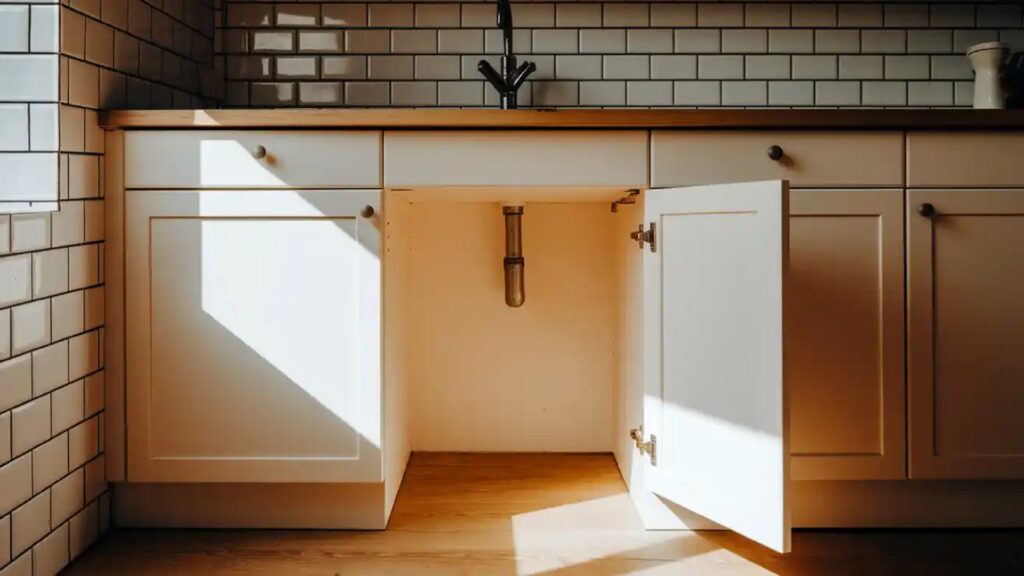
FAQs About Kitchen Sink
What is the best material for a kitchen sink?
Stainless steel is the most popular for durability and affordability. Granite composite and fireclay are also excellent for style and scrtch resistance.
How often should I clean my kitchen sink?
You should clean your kitchen sink daily with mild soap and wekly with baking soda or vinegar to prevent stains and odors.
Can I install a new kitchen sink myself?
Yes, if you’re handy and replacing a like-for-like model. For, new installtions or complx plumbng, hiring a professional is safer and ensures code compliance.
How do I prevent clogs in my kitchen sink?
Use a drain strainer, avoid pouring grease or coffee grounds down the drain, and flush with hot water weekly to keep thngs flowng smothly.
Is a single or double bowl kitchen sink better?
It depends on your needs. Single bowls are better for large pots and small spaces, while double bowls allow for multitasking like soaking and rinsing.
Author Remarks
The kitchen sink is a central part of your daily life, more important than many people realize. It affects how you prep food, clean up, and even how your kitchen looks and feels. From choosing the right size and matrial to installing it correctly and maintaining it over time, every detal matters.
Avoiding common mistakes and using your kitchen sink efficiently can boost hygiene, save time, and even increase your home’s value. Whther you’r planning a remodel or upgrading a fixture, let this guide be your go-to resource for all things related to the kitchen sink.
Ready to make the right choice? Start with your space, your habits, and this guide, and your perfct kitchen sink is just a few decisions away.

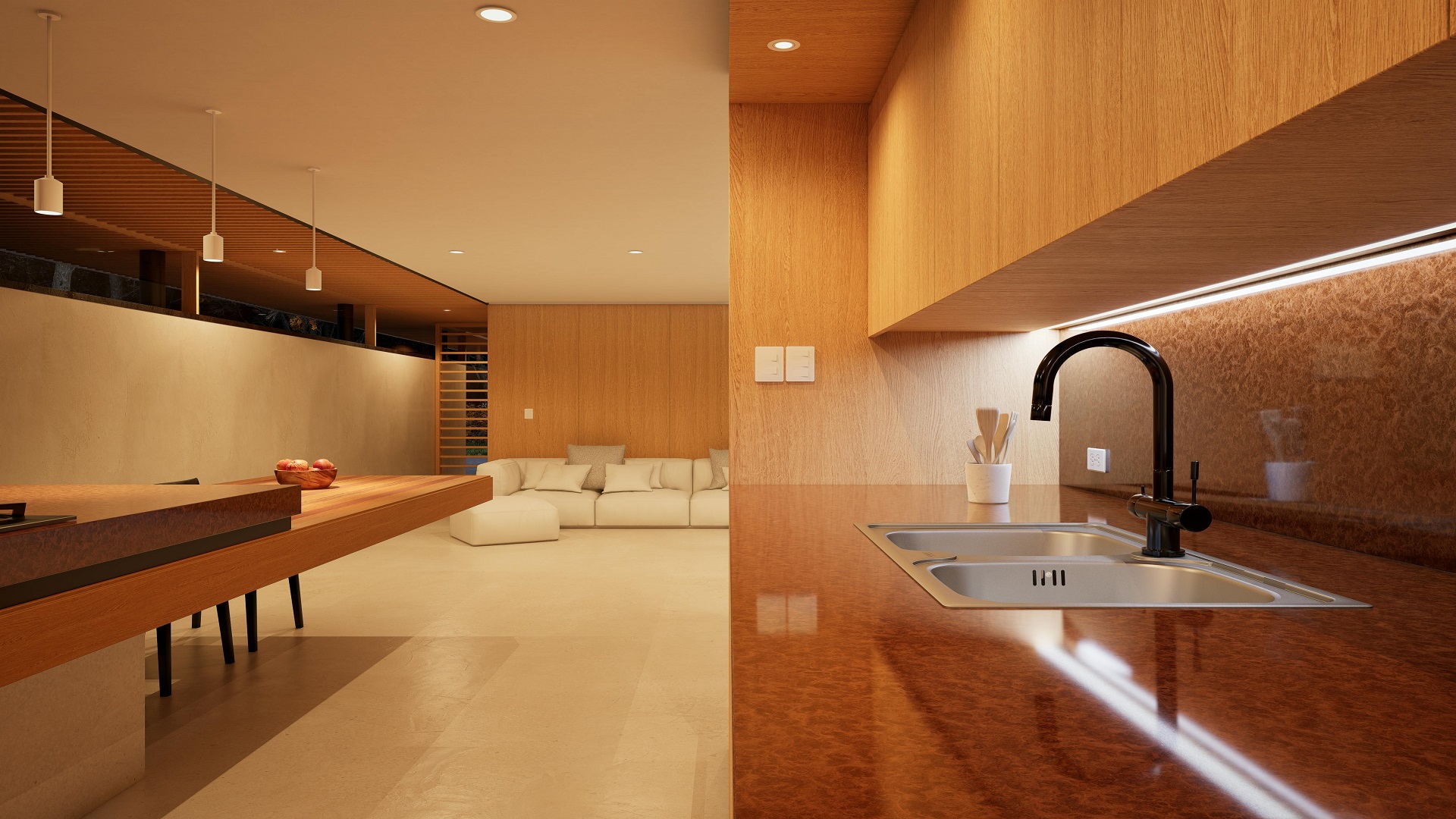
2 Comments